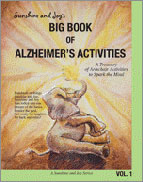 |
| |
The Alzheimer's Disease Bookstore | ||
* |
Read this article to learn more about Activities books, and how to use them: Activity Books Provide Alzheimer’s Patients and Caregivers with Joy-filled Times by Gayle Irwin
Author of a series of four books, she knows the challenges of caregiving. Her mother has suffered with Alzheimer’s for more than a decade, and Jill has been her caregiver for nearly eight years. She became frustrated trying to find appropriate activities, especially as the disease progressed. Jill’s frustration created a crop – ideas, activities, and a desire to help others became the foundation for The Big Book of Alzheimer’s Activities. “After an exhaustive and fruitless search for material written in an elementary format with adult subject matter, I set out to write a series of books myself,” she says. “Few mid- to late-stage Alzheimer’s patients can recall more than the last sentence that was said to them, so my basic credo was that virtually every sentence in the books must stand alone as an activity.” Each book contains more than 100 activities “specially crafted to elicit verbal participation,” in persons with mid- to late-stage Alzheimer’s disease, Jill says. “The activities cover an array of topics, including history, popular TV shows, movies, music, sports, literature, art, cooking, nature, and much more,” she adds. Within the books, caregivers will find activities that involve observation, art, listening, singing, recalling, reminiscing, and matching, among other opportunities. The activities are fun and stimulating, according to Jill. “Amusing and keeping the mind of a person with Alzheimer’s stimulated can be a frustrating and exhausting undertaking,” she says. “The Big Book of Alzheimer’s Activities series provides all the material needed to accomplish both tasks in a way that is fun for both caregivers and persons with Alzheimer’s.” “There is something for everyone in every volume,” Jill says. “There are activities that appeal to both men and women, and all of the activities are geared toward the generation currently apt to be affected by Alzheimer’s.” The books are very user-friendly as well as transportable, and the activities are conversation-oriented, with no additional materials needed to use them. Caregivers can simply open the book to a page and begin, Jill explains. “There is a helpful hints section at the beginning of each volume that explains how to adapt activities to make them simpler or more challenging, depending on whether the person is in an earlier or later stage of Alzheimer’s,” she explains. “The books can be used at home and can be a portable resource for road trips or long waits at a doctor’s office.” People with Alzheimer’s disease have short attention spans, therefore, the activities in Jill’s books are short. Caregivers can use the activities for one or two minutes or the activities can be extended and used for several hours or even during the course of several days. The caregiver decides what is best for their patient or loved one and for that particular time. The activities are appropriate for use either with individuals or in a group setting. Jill advises caregivers use the activities when little to nothing else is going on around them. She believes persons with Alzheimer’s, whom she calls “pals”, respond better in quieter settings. “Pals are not always able to distinguish between a voice coming from a television or another person in the room and a caregiver's voice,” she explains. “I believe it sounds to them like a steady stream of jumbled words. Caregivers should strive for a setting where the pal can hear only the caregiver’s voice.” “The goal of the activities in my books is always participation, not accuracy,” she adds. “Never tell a pal ‘You’re wrong,’” Jill advises caregivers. “There is nothing to be gained by pointing out a pal’s incorrect response to a question. It’s counterproductive and the pal may just stop responding at all so as to not disappoint. Don't let your pal slip into silence." Both pals and caregivers benefit from using the books, Jill adds. “Sometimes I hear a caregiver say their pal is too advanced in the illness to be able to do any kind of activity. If a pal doesn’t respond, it doesn’t necessarily mean he or she did not process what was said. The act of listening is a form of stimulation. Stimulation may slow the progression of Alzheimer’s. I can’t emphasize this enough,” she says. Jill’s mother is the inspiration for her activity books and the reason she continues writing, and trying to help others. “Passing along what I’ve learned has provided some small satisfaction that my mother and I have somehow tackled the disease,” Jill says. “The heartwarming, positive feedback from people who have been helped by the books is what has spurred me to continue writing. “Laughter is the best medicine,” Jill concludes. “Alzheimer’s is hard on pals and caregivers alike. The Big Book of Alzheimer’s Activities series is filled with opportunities for laughter and smiles. Despite the many hardships caused by the illness, my mother and I still find a lot of joy in living.” Jill lives in Texas with her husband, an artist, and her mother. She enjoys spending time with family and friends and her three dogs, traveling, dancing, and riding scooters. Order the book by clicking on the "Add to Cart" button.
|
********* Copyright AlzheimersBooks.com for Alzheimer's Disease 2013. All rights reserved. This website was built by Ewisoft Website Builder. |


